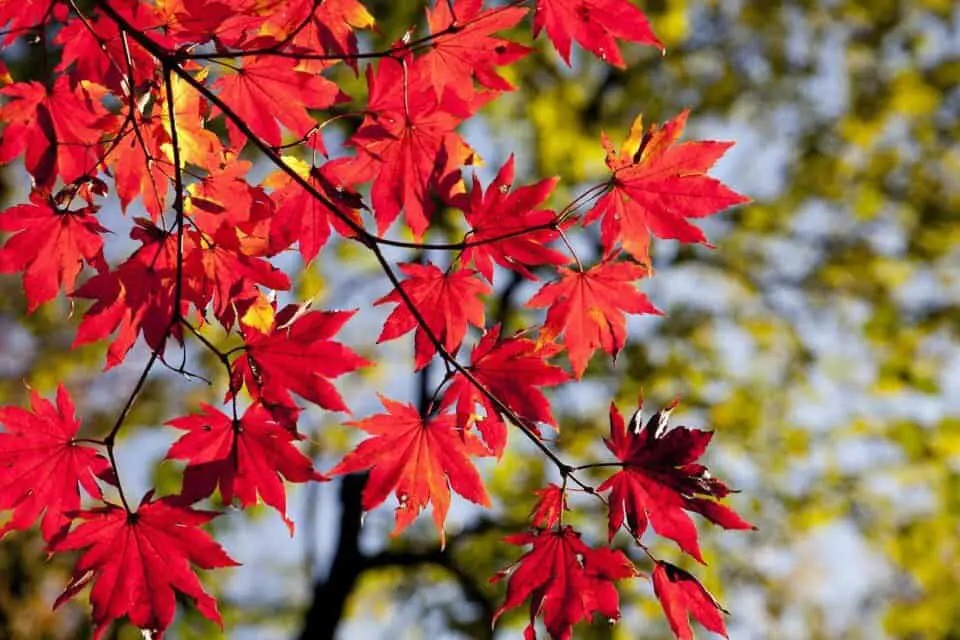Some links in the post are affiliate links and I get a commission from purchases made through some links found in the post.
We all know that red maples turn red in the fall. So, a friend went to a nursery in the fall and picked out a red maple. It had bright red foliage, and she marveled at its beauty.
Come winter, the leaves fell off, and she was eager for spring to start so that the red leaves would be back. Imagine her disbelief when the leaves came out green!
She was sure that something was wrong with the tree. She fed it, watered it, moved it to the sunniest spot in the house, and still, nothing!
Frustrated, she reached out to our group, asking what was wrong with her tree. We all laughed as we explained that the red leaves would only show in the fall once anthocyanins took over from chlorophyll.
She was happy to hear that and has since been patient enough with the seasonal changes. Besides, the tree still has red leaves in the spring, so she does not miss much.
Could this be similar to the problems in your red maple? Often, some of the tree’s issues require you to be a little patient, and things will work out well.
And at others, the issues stem from not meeting the tree’s care requirements. I will break down the issues that may arise when growing the red maple.
The common causes of problems with red maple due to underwatering, overwatering, lack of fertilizer and lighting issues.
This can lead to your red maple developing problems such as the leaves turning brown, yellow, green, drooping and not blooming.
Red maples naturally can be slow to establish, susceptible to trunk damage and have poor branch structure.
You will see that one problem can be to blame for a myriad of other changes in your tree.
Let’s get started:
What Are the Common Red Maple Problems and How Can You Fix Them?
Have you noticed a change in your red maple tree? Maybe its growth has stunted. Or the tree’s leaves are falling off. Perhaps its leaves have turned green in the fall. What could be the issue? We find out:
Why is My Red Maple Not Growing?
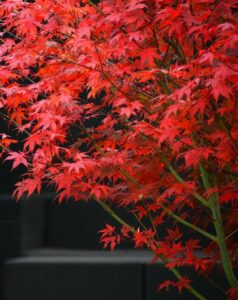 Every gardener hopes to see their red maple, also known as the trident red maple, grow to its full height. This tree can be as tall as 70 feet (21 meters) with a spread of 50 feet (15 meters) in the right conditions.
Every gardener hopes to see their red maple, also known as the trident red maple, grow to its full height. This tree can be as tall as 70 feet (21 meters) with a spread of 50 feet (15 meters) in the right conditions.
Indoors, the tree will not grow this much because its root system cannot establish as much as it would outdoors.
Of course, the growth is not exponential, and the tree will not reach this height within its first year. It won’t even reach this full height in its first five years. However, the tree should show several inches of growth each year.
So, what can bar the tree from growing to its full height or gaining those extra inches annually?
a. The Red Maple May be Underwatered
The red maple is relatively easy to care for, especially when established. However, slow growth may exhibit if you deprive it of water long enough. But why is this the case?
Young maples require slightly moist soil as this enables them to use the nutrients and light available to photosynthesize.
This process results in food creation, which gives the tree the energy to produce more leaves and grow wider and taller.
Older trees are not specific about water because their extensive roots can reach the water tables underneath the ground. These trees can even do well in dry soils.
However, they have a caveat – when they don’t receive rain for too long, they require you to step in and water the earth to moisten the soil and allow the uptake of nutrients for photosynthesis.
How Can You Prevent Underwatering?
Your red maple should never go long periods without water. Doing so robs it of the ability to photosynthesize, which results in slow or no growth. So, how should you water the red maple?
Mulch the tree
Your red maple will be less likely to suffer underwatering if it can conserve the moisture in the ground. Using mulch is an easy way to do this, reducing evaporation rates, especially in the summer.
Besides, it also keeps weeds down and gives your tree less competition for nutrients. To mulch the tree, use an inch of mulch around the root zone, observing at least a foot away from the tree’s base.
Using mulch next to the tree’s base decreases air circulation and creates a humid environment ideal for the growth of fungi and other pests and diseases that can attack the red maple.
Check the soil
Before watering the tree, you should always check how dry the soil is by digging into the top two inches– if the soil feels moist to the touch, you should not water it.
Instead, you should wait two to three more days before rechecking it. Please note that overwatering can be fatal to the tree, and it’s best to neglect the tree than drown its roots.
If the soil feels dry, you should water it slowly and thoroughly. Use 10 gallons of water for every inch of the tree’s diameter.
Even if it’s hot, stick to this rule of thumb. When the soil dries again, you can water it again using the same amount of water.
Watering times
Water the tree in the early morning or late evening when the temperatures are low – this enables the roots to soak in most of the moisture before evaporation rates increase.
To better the soaking, you can use a water bag or drip irrigation system that allows the soil to absorb the water slowly, increasing the water uptake in the tree.
Underwatering is common during the summer and when the tree has access to full sun. If the soil dries up too fast, you may want to amend it with compost to increase its water retention rate.
b The Tree May Be Overwatered
While neglecting the red maple is frowned upon, overwatering the tree is worse. It’s unlikely that your tree would die from lack of water.
Established trees can even withstand drought for prolonged periods. But overwatering? It takes a few days or weeks of overwatering for your tree’s roots to drown and die. How does it work?
When you water the red maple, the tree’s roots absorb what the tree can use. This water plays a vital role in photosynthesis and also evaporates from the leaves, enabling the tree to keep cool in the heat.
But you should remember that the red maple has highly dissected leaves and thus won’t lose much to the environment via evaporation.
So, the tree stops taking up as much water at some point. What happens? Well, the roots keep sitting in the water you have provided because the soil has taken up enough and is saturated.
And when this happens, the water pushes the air out of the air pockets, taking up the space suited for oxygen – this creates an environment ideal for the growth of fungi and other disease-causing microorganisms.
These attack the roots, damaging them, and making it harder for them to absorb water and nutrients.
You can tell that root damage has started when:
- The red maple suffers stunted growth,
- The red maple stem starts turning black,
- The red maple leaves start yellowing.
Please note that you must act fast to prevent the overwatering from turning into root rot. Once the tree gets to this stage, and its roots become soggy, it’s likely to die unless you transplant it.
How Can You Prevent Overwatering?
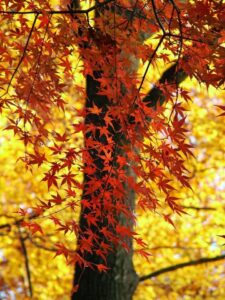 The best way to deal with overwatering is to slow down when watering the tree. You should only water it when the top two inches of the soil feel dry. If this does not work, you can try:
The best way to deal with overwatering is to slow down when watering the tree. You should only water it when the top two inches of the soil feel dry. If this does not work, you can try:
- Amending the soil: If the soil used retains too much moisture, you can amend it with sand and other coarse materials to allow the excess water to drain.
- Moving the tree: Sometimes, the tree is in a shaded location that deprives it of light. And without light, the tree cannot make much use of the water in the soil. So, even when you reduce the watering frequency, the tree still sits in the water.
With these measures in place, coupled with sound watering techniques as those outlined in underwatering, your tree should recover soon.
What if the red maple has suffered root rot? Root rot exhibits as soggy white roots. If this is the case, assess how much damage has occurred.
If the rot has affected more than 50% of the root, you may need to discard the tree. If not, you can cut off the affected parts with a clean and sharp tool, apply fungicide to the roots, and move the tree to a less moist location.
You may also like: What are the common bloodgood Japanese maple tree problems
c. The Tree Needs More Fertilizer
The red maple can grow devoid of the use of fertilizers. However, you may need to occasionally step in with a general-purpose fertilizer to amend the soil. How can you tell that the tree may need feeding?
- The tree has slowed or no growth,
- The tree is prone to pest and disease attacks, and
- The tree has yellowing leaves with green veins.
The issues can also arise from other unmet red maple needs. Thus, before feeding the soil with any feed, you should conduct a soil test to ascertain which nutrients are present and their levels.
In some cases, the abundance of one nutrient can hinder the uptake of other nutrients.
Also, the soil pH can stand in the way of adequate nutrient absorption. The red maple does best in slightly acidic to neutral soils with a pH of 4.5 to 6.5.
In alkaline conditions, the tree develops chlorosis and suffers slow growth. You can test the soil pH using a kit available in your nearest gardening store.
Dealing with Underfeeding
If you’re sure that your red maple needs feeding, you can proceed as follows:
- You can feed the soil with a commercial feed with ratios 10-4-6 or 16-4-8: These should be diluted to half their strength to avoid overpowering the tree, or
- You can use organic inputs such as compost and coffee grounds to feed the tree slowly.
But if chlorosis is the issue, you can amend the soil by acidifying it using coffee grounds and other acidic materials. Then check its pH to ensure it falls within the suitable range.
d. The Tree Has Lighting Issues
Every tree needs light to make enough food to support its growth. And the red maple does best in USDA zones 3 to 9.
It does well in the full sun in the lower zones, i.e., bright and direct light. In the higher zones, it prefers partial sun, i.e., bright and indirect light. When you give it more light than it needs, the tree:
- Shows browning on its leaves,
- Has drooping or dropping leaves, and
- Suffers slow growth.
When you place it in low light, the tree:
- Suffers stunted growth,
- Is at risk of overwatering,
- Does not bloom as expected, and
- Is at more risk of pest attacks.
How Can You Give the Tree Adequate Light?
The first thing is to consider where you live. People in hot climates should position their trees in the partial sun, while those in cooler regions should do so in the full sun. Here’s how you do this:
- Full sun: You can get this exposure in the south of the garden if you live in the northern hemisphere or the north if you live in the southern hemisphere.
- Partial sun: You can get this exposure to the east of the garden. The west also has such exposure, but the afternoon sun is too harsh in the hotter regions.
Ensure the tree gets at least 6 hours of sun exposure, and it should be fine.
You may also like: Japanese maple vs red maple
Why is My Red Maple Turning Brown?
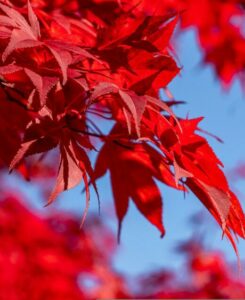 Browning leaves are not part of what you expect in the red maple seasonal changes. Depending on the season, you can expect the leaves to be green or red.
Browning leaves are not part of what you expect in the red maple seasonal changes. Depending on the season, you can expect the leaves to be green or red.
However, browning also fits into the active growing season. Why? As the leaves mature and prepare to fall off the tree, the cellular activities reduce, and the leaves receive fewer nutrients.
It’s part of their natural cycle, and soon enough, the leaves start browning, having lost their vigor and chlorophyll.
And eventually, they crumple, fall off the tree, and land on the ground. There, they feed the tree by decomposing and releasing key nutrients into the soil.
Please note that browning is only normal if it shows on mature leaves. You should be concerned if you notice it in young and emerging leaves. Such changes can result from:
- The tree lacking adequate water, especially in the summer. When the tree’s leaves are exposed to high temperatures, they lose a lot of water via transpiration and evaporation. As such, the tree’s roots must absorb an equivalent amount of water to support cellular activities. If this does not happen, the tree’s leaves start dehydrating and browning, thus dying and falling off the tree prematurely.
- The tree may be exposed to too much light and heat, dehydrating it.
Why is My Red Maple Turning Yellow?
Is yellowing normal in the red maple? Not quite. Yellowing, like browning, can occur in older leaves as they come to the end of their lives.
But if the yellowing presents in younger or emerging leaves, you should have a reason for concern. What can cause premature yellowing?
- The tree is overwatered: In most cases, yellowing is the first warning sign that your red maple’s roots are sitting in oxygen-deficient water. And if you do not heed this warning, the root damage and attack continue and destroy the roots, making them soggy. Eventually, the tree’s stem starts turning black, unable to transport water and nutrients. And the tree can die. So, you cannot afford to ignore any yellowing on the tree’s leaves.
- The tree may be underfed, compromising its ability to make chlorophyll and thus enough food for the tree.
Why Does My Red Maple Have Drooping Leaves?
Does your red maple have leaves that appear wilted? That’s a clear sign of dehydration. What can cause this?
- Not watering your red maple enough, especially in the hotter months when the temperatures can get out of control
- The tree may be exposed to too much heat or light with inadequate compensation for its water loss via transpiration and evaporation.
Why is My Red Maple Dropping Leaves?
As part of the seasonal red maple changes, you can expect its leaves to fall out at some point. This change happens in the late fall as the tree prepares for the winter.
And there’s nothing wrong with the tree – it is a deciduous tree and is bound to lose its leaves at some point. But if the leaf drop is not taking place towards the end of fall, you may want to consider the following culprits:
- The tree may be in too much light or heat,
- The tree may be underfed, or
- The tree may be underwatered.
Why is My Red Maple Not Blooming/ Turning Green?
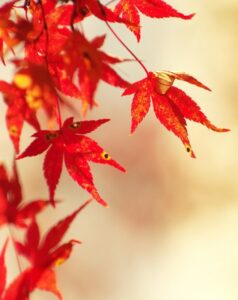 Your red maple should bloom in the spring, producing small red flowers. If it does not bloom, it is either too young or still adjusting after being transplanted.
Your red maple should bloom in the spring, producing small red flowers. If it does not bloom, it is either too young or still adjusting after being transplanted.
But if these are not the reasons, the tree may not have access to its vital growing requirements:
- Water,
- Light
Your red maple leaves will only turn red in the fall. If this does not happen, consider the same reasons outlined under not blooming.
Final Thoughts
See? Narrowing down the factors that result in red maple problems is relatively easy. You need to ask yourself what your tree needs, what you are giving it, and what you are not giving it.
Once you list down the items in the latter case, you will nab your culprit.
Happy Gardening!

